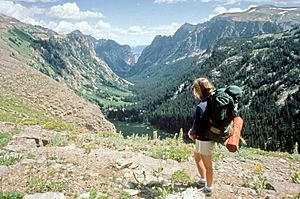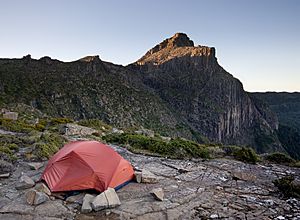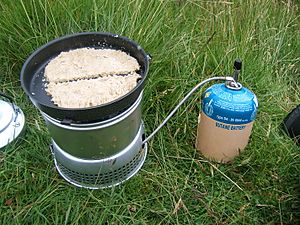Backpacking (wilderness) facts for kids
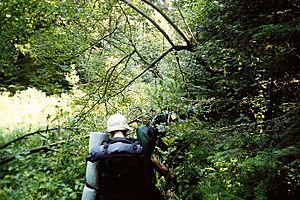
Backpacking is an exciting outdoor activity. It means carrying all your gear in a backpack for trips that last at least one night. You might carry food, water, a sleeping bag, a tent, clothes, and a small stove. Keeping your pack light is super important! Backpacking trips can last for days, weeks, or even months. Sometimes, people plan stops to get more supplies along the way.
When you go backpacking, it's important to protect nature. This means staying on marked trails and not bothering plants or animals. Always carry out any trash you create. The idea of "Leave No Trace" is simple: "Leave nothing but footprints. Take nothing but photos. Kill nothing but time. Keep nothing but memories." This helps keep nature beautiful for everyone.
Backpackers need to be ready for anything. This includes bad weather, tough trails, or tricky water crossings. You might also face dangerous animals, or health issues like dehydration (not enough water) or hypothermia (getting too cold). Being far from help means you need to know survival skills and carry survival gear.
Contents
Where Do Backpackers Stay?
Backpacking camps are usually quite simple. They are not like car camping sites with lots of facilities. In popular areas, a hike-in campsite might have a fire ring (if fires are allowed). It might also have a simple outhouse and a bulletin board with a map. Many camps are just flat spots of ground without bushes. In very wild areas, you choose your own spot. The main rule is to "leave no trace" when you go.
In places like Scotland, there are simple, free shelters called bothies for backpackers. In France, on long trails called Grande Randonnées, you can stay in gîtes d'etapes. These are simple hostels for walkers and cyclists. North America also has some simple shelters and mountain huts, like on the Appalachian Trail. The High Sierra Camps in Yosemite National Park are another example.
What Gear Do You Need?
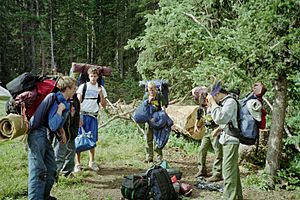
Your backpacking gear starts with a good backpack that fits you well. Next, you need clothes and shoes that are right for the weather. Then comes enough food. A sleeping system, usually a sleeping bag and a foam pad, is also key. Finally, you need some survival gear that fits your trip and skill level. After these basics, everything else is extra!
A good shelter, like a tent, is usually the next important item. It should be suitable for the weather you expect.
Water for Your Trip
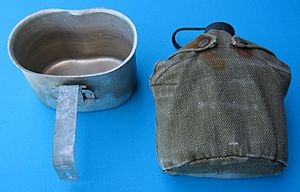
You must plan for enough water before your trip. Know where you can find clean water sources like lakes, streams, or springs. Or, bring a way to filter or clean water you find.
Even in clean-looking areas, water often needs treatment. This protects you from waterborne diseases caused by tiny bacteria and protozoa. Here are the main ways to treat water:
- Boiling it over a fire or stove.
- Using chemicals like chlorine or iodine.
- Filtering it (often used with chemicals).
- Treating it with ultraviolet light.
You can carry water in bottles or soft plastic bags. Hydration packs, which are like water bladders you wear, are also very popular.
Food for Backpacking

Backpacking uses a lot of energy. So, you need to bring enough food to stay strong and healthy. Just like with gear, food weight is very important. Foods that give you lots of energy, last a long time, and are light are the best.
You also need the right cooking gear and fuel. Small, lightweight campstoves and cooking pots are common. Many hikers use freeze-dried meals. You just add boiling water to these for a hot meal. Another option is special food that heats up with a chemical reaction, so you don't need a stove. These types of foods are often inspired by military meals like MREs.
Winter Backpacking
Winter backpacking needs more skill and special gear. You might need skis or snowshoes to walk through deep snow. Or, you might use crampons and an ice axe for icy areas. Warm sleeping bags and tents are a must. Your clothes should be waterproof and keep moisture away from your body. Cotton clothes are bad in the cold because they stay wet and make you cold.
You can also make a winter shelter called a snow cave. It works like an igloo to keep you warm and safe from wind. A good snow cave can be 0 °C (32 °F) inside, even if it's super cold outside (−40 °C or −40 °F). You dig into the snow, making the entrance lower than the main sleeping area to trap warm air. A quinzhee is similar, but you build a mound of snow first, then dig into it.
Important Skills and Safety
- Survival skills help you stay calm and safe if things go wrong. This is especially true if the weather or trail changes unexpectedly.
- Navigation and orienteering skills are key. They help you find your way to the starting point, follow your route, and get back out. If you get lost, these skills help you figure out where you are.
- First aid is very important. Knowing how to treat small injuries like splinters or sprains is a basic skill. It's also vital to recognize and treat serious issues like hypothermia (too cold) or dehydration (not enough water).
- Leave No Trace is like the Golden Rule for backpackers. If you want beautiful places to explore, you need to help keep them that way. At the very least, don't make them worse.
- Knowing how to send a distress signal is a last resort skill.
Fun Facts About Backpacking
- A good rule is that your packed backpack should weigh no more than 25% of your own body weight.
- Drinking enough water, or hydration, is super important. Depending on the weather, trail, and how fit you are, you might need 2 to 8 liters (about 1/2 to 2 gallons) of water or more each day.
- Winter backpackers wear wool or synthetic fabrics like nylon. These materials don't hold moisture and help sweat dry quickly. Wearing layers of clothing is essential. Wet clothes can make you very cold and lead to frostbite or hypothermia.
- Backpackers often put their food in plastic bags. They avoid heavy jars and cans to save weight.
- Humans can safely carry up to about 50 pounds (23 kg). Carrying weight can be good exercise for your heart and can help prevent injuries.
- Carrying loads might have been one of the things that made humans different from other animals long ago.
Images for kids
-
A backpacker during the California Gold Rush
-
Expedition cycle touring, Torres del Paine National Park.


